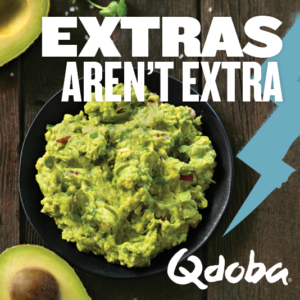-
 7 min. read
7 min. read
-
 Trevin Shirey
Trevin Shirey VP of Marketing
VP of Marketing
- Trevin serves as the VP of Marketing at WebFX. He has worked on over 450 marketing campaigns and has been building websites for over 25 years. His work has been featured by Search Engine Land, USA Today, Fast Company and Inc.
The other afternoon, when I was driving down the highway, I noticed a Qdoba billboard that said in, enormous letters, “freedom tastes like guacamole.” At first I laughed. Then as I got closer, I read the rest of the text, which included the phrase “extras aren’t extra.” Now instead of laughing, I was intrigued. And suddenly very hungry for a burrito with extra guac.
 I’ve never eaten at Qdoba. But I have eaten at plenty of other burrito shops, which typically charge between $1 and $1.50 for extra guacamole, sour cream, queso, and pretty much everything else I enjoy putting on my food. So when I pulled up Qdoba’s #freeyourflavor campaign a little later, and found out that the premise was exactly as they succinctly explained it on that billboard — that guacamole was free instead of a buck — I decided to pay them a visit.
I’ve never eaten at Qdoba. But I have eaten at plenty of other burrito shops, which typically charge between $1 and $1.50 for extra guacamole, sour cream, queso, and pretty much everything else I enjoy putting on my food. So when I pulled up Qdoba’s #freeyourflavor campaign a little later, and found out that the premise was exactly as they succinctly explained it on that billboard — that guacamole was free instead of a buck — I decided to pay them a visit.
Qdoba’s latest marketing campaign isn’t just supposed to make you hungry for a burrito: it’s a shining example of the power of what you can accomplish when you address customer pain points.
What Are Customer Pain Points?
Charging extra for burrito toppings is a pretty well known complaint; “why does guacamole cost extra” and “why does Chipotle charge so much for guacamole” are both highly searched phrases on Google. (If you aren’t familiar with Chipotle, it’s one of Qdoba’s competitors.
This may be important to know.) It’s only a dollar, but at the same time, it’s a dollar for a little bit of avocado, tomato, and salt that probably cost just a few cents to make. Guacamole always costing extra at burrito shops, despite being so cheap to produce, is a major annoyance. But Qdoba was able to address that annoyance by making it free.
That’s the definition of a pain point — something that causes a customer discomfort or annoyance that your business can solve.
What Kinds of Pain Points Do Customers Have?
 Your customers can have various kinds of pain points, both big and small. They may be incredibly obvious, and they may complain about them at length on social media at every given opportunity, or they may be dormant, and only a little prompting will get them to say “oh yeah…” and talk to you about them. The Qdoba example is a relatively small pain point, but it affects a very large amount of people, and they’re pretty vocal about it.
Your customers can have various kinds of pain points, both big and small. They may be incredibly obvious, and they may complain about them at length on social media at every given opportunity, or they may be dormant, and only a little prompting will get them to say “oh yeah…” and talk to you about them. The Qdoba example is a relatively small pain point, but it affects a very large amount of people, and they’re pretty vocal about it.
On the other hand, I have a pain point with a major shipping company that affects only me. It involves them repeatedly leaving my deliveries out in my driveway in the rain instead of on my covered side porch. It’s annoying and could potentially cost me hundreds of dollars, but beyond one phone call (to ensure a laptop delivery wasn’t ruined!), I’ve never really complained about it, and am only bringing it up now because of this post.
Just because a pain point is dormant doesn’t mean it isn’t worth addressing. In fact, by identifying and resolving these issues, you can strengthen your business… and perhaps even bring on more customers.
How Can I Identify Customer Pain Points?
In October, USA Today ran a story on Qdoba’s pricing changes. Tim Casey, brand president, explained that both customers and Qdoba team members complained about the charges for guacamole, queso, and other add-ons, saying they felt like they were being nickel-and-dimed. According to a survey cited in the article:
Many customers who were surveyed said that they were fed up with the surcharges [for extras].
Some 78% of those surveyed said they “hate” having to pay for extras, and 81% said they don’t think that they should have to.
In Qdoba’s case, they conducted a customer survey. You could do the same thing — and in fact, this is the best way to find pain points: by asking. Identifying the pain points your customers have can be done by a few methods, including:
- Sending out email or hosting online surveys
- Making personal phone calls
- Looking for non-branded company mentions on social media
- Asking opinions in person — although this is rarely the best option (people are usually much nicer face-to-face!)
You may have pre-conceived notions about where your customers might have pain points, but you may find that what bothers you about your products, services, or website doesn’t even phase them. So it’s best to ask open-ended questions and let them do the talking.
Questions to Ask
Ask questions like these:
- “What annoys you about…?”
- “If you could change one thing about… what would it be?”
- “What do you think is the most difficult part of…?”
- “Where do we have room to improve?”
- “What can we do better?”
- “Have you had any negative experiences with…?”
- “If you were CEO for a day, what changes would you make?”
- “What’s one small thing we could do that would have a big impact?”
These may seem like questions that will encourage negative answers, but you don’t have to ask all of them. Pick one or two and go from there. You can include them as part of a general survey with some more positive questions, too.
When you start getting answers, look for a trend. If more than 30-40% of your customers agree that something is bothering them, you’ve probably found a pain point.
How to Encourage Responses
 “Can I really make customers answer a survey about me?” Yes!
“Can I really make customers answer a survey about me?” Yes!
However, sometimes the trick is convincing them to do it. Customers may not always be excited about the prospect of giving feedback, after all. You can encourage responses by:
- Being extremely honest — sometimes the key is to say “we’re doing this because we want to be a better company”
- Offering something in exchange, like a 20% off coupon or chance to win a prize
- Not interrupting them — if you use a pop-up, adjust the timing so it only comes up for return visitors or repeat customers who have been on the site a while
- Keep it short and sweet, and even establish the length at the start (“This three question survey…”)
The Cost Effectiveness of Addressing Pain Points
One concern that may come up is how much taking care of pain points may cost you. Going by Qdoba’s example, roughly 35% of their customers used to pay $1-2 additional per order for extras like guacamole and queso. Without these charges, the chain could be losing thousands of dollars per day, right?
The USA Today article mentioned how the chain plans to balance out this adjustment in pricing:
That’s a lot of additional income the company is leaving on the table in an attempt to make customers feel better about the brand. In some cases, the company will slightly increase menu prices and, in other cases, decrease prices, as part of this change.
However, it’s worth noting that addressing pain points can dramatically improve your brand and company image, to the point that you may gain new revenue and customers. As one industry expert interviewed for the article stated:
“It’s much more important to get a customer back five times than to make the most you can off of them one time,” says Gregg Rapp, an industry consultant and menu engineer.
Try to remain sensible when you are addressing pain points.
If every single one of your customers complain that your service is too expensive, you should absolutely reduce its cost — but don’t do so at the risk of putting your company out of business. Instead, consider reducing the cost of your service while cutting back on expenses to balance it out. Now that you know everything there is to know about identifying and resolving customer pain points, do you plan to do some research to improve your products, services, or business?
Do you have any other examples of pain points you’d like to share with me? Are you also really hungry for a burrito right now? Feel free to chime in below, I’d love to hear from you!
-
 Trevin serves as the VP of Marketing at WebFX. He has worked on over 450 marketing campaigns and has been building websites for over 25 years. His work has been featured by Search Engine Land, USA Today, Fast Company and Inc.
Trevin serves as the VP of Marketing at WebFX. He has worked on over 450 marketing campaigns and has been building websites for over 25 years. His work has been featured by Search Engine Land, USA Today, Fast Company and Inc. -

WebFX is a full-service marketing agency with 1,100+ client reviews and a 4.9-star rating on Clutch! Find out how our expert team and revenue-accelerating tech can drive results for you! Learn more
Try our free Marketing Calculator
Craft a tailored online marketing strategy! Utilize our free Internet marketing calculator for a custom plan based on your location, reach, timeframe, and budget.
Plan Your Marketing Budget

Maximize Your Marketing ROI
Claim your free eBook packed with proven strategies to boost your marketing efforts.
Get the GuideTry our free Marketing Calculator
Craft a tailored online marketing strategy! Utilize our free Internet marketing calculator for a custom plan based on your location, reach, timeframe, and budget.
Plan Your Marketing Budget





